Plasmonic Nanostructures for Broadband Solar Absorption Based on Synergistic Effect of Multiple Absorption Mechanisms
Abstract
1. Introduction
2. Structure Design and Simulation Method
3. Results and Discussion
3.1. Meta-Structure Absorber for Solar Energy Harvesting
3.2. Underlying Mechanisms of the Broadband Absorption
3.3. Geometric Effects on Spectral Absorption Performance at Normal Incidence
3.3.1. The Size Effect of Topmost W Truncated Cone
3.3.2. The Effect of the Thickness of the Top W Layer and the Intermediate Al2O3 Layer in the MIM Structure
3.3.3. The Effect of the Period
3.4. The Effect of Polarization Angle and Oblique Incident Angle
4. Conclusions
Author Contributions
Funding
Institutional Review Board Statement
Informed Consent Statement
Data Availability Statement
Conflicts of Interest
References
- Zhang, N.; Qi, M.Y.; Yuan, L.; Fu, X.; Tang, Z.R.; Gong, J.; Xu, Y.J. Broadband light harvesting and unidirectional electron flow for efficient electron accumulation for hydrogen generation. Angew. Chem. 2019, 131, 10108–10112. [Google Scholar] [CrossRef]
- Wang, Y.; Li, J.; Hu, Q.; Hao, M.; Liu, Y.; Gong, L.; Li, R.; Huang, X. Boosting visible-light-driven photocatalytic hydrogen production through sensitizing TiO2 via novel nanoclusters. ACS Appl. Mater. Interfaces 2021, 13, 40562–40570. [Google Scholar] [CrossRef] [PubMed]
- Wu, D.; Guo, J.; Du, J.; Xia, C.; Zeng, L.; Tian, Y.; Shi, Z.; Tian, Y.; Li, X.J.; Tsang, Y.H. Highly polarization-sensitive, broadband, self-powered photodetector based on graphene/PdSe2/germanium heterojunction. ACS Nano 2019, 13, 9907–9917. [Google Scholar] [CrossRef]
- Fırat, M.; Radhakrishnan, H.S.; Payo, M.R.; Choulat, P.; Badran, H.; van der Heide, A.; Govaerts, J.; Duerinckx, F.; Tous, L.; Hajjiah, A. Large-area bifacial n-TOPCon solar cells with in situ phosphorus-doped LPCVD poly-Si passivating contacts. Sol. Energy Mater. Sol. Cells 2022, 236, 111544. [Google Scholar] [CrossRef]
- Dang, Z.; Wang, W.; Chen, J.; Walker, E.S.; Bank, S.R.; Akinwande, D.; Ni, Z.; Tao, L. Vis-NIR photodetector with microsecond response enabled by 2D bismuth/Si (111) heterojunction. 2D Mater. 2021, 8, 035002. [Google Scholar] [CrossRef]
- Liu, M.; Wang, J.; Yang, K.; Zhao, Z.; Zhou, Z.; Ma, Y.; Shen, L.; Ma, X.; Zhang, F. Highly sensitive, broad-band organic photomultiplication-type photodetectors covering UV-Vis-NIR. J. Mater. Chem. C 2021, 9, 6357–6364. [Google Scholar] [CrossRef]
- Bellucci, A.; Calvani, P.; Girolami, M.; Orlando, S.; Polini, R.; Trucchi, D.M. Optimization of black diamond films for solar energy conversion. Appl. Surf. Sci. 2016, 380, 8–11. [Google Scholar] [CrossRef]
- Trucchi, D.M.; Bellucci, A.; Girolami, M.; Calvani, P.; Cappelli, E.; Orlando, S.; Polini, R.; Silvestroni, L.; Sciti, D.; Kribus, A. Solar Thermionic-Thermoelectric Generator (ST2G): Concept, Materials Engineering, and Prototype Demonstration. Adv. Energy Mater. 2018, 8, 1802310. [Google Scholar] [CrossRef]
- Mascaretti, L.; Schirato, A.; Zbořil, R.; Kment, Š.; Schmuki, P.; Alabastri, A.; Naldoni, A. Solar steam generation on scalable ultrathin thermoplasmonic TiN nanocavity arrays. Nano Energy 2021, 83, 105828. [Google Scholar] [CrossRef]
- Huang, Z.; Li, S.; Cui, X.; Wan, Y.; Xiao, Y.; Tian, S.; Wang, H.; Li, X.; Zhao, Q.; Lee, C.-S. A broadband aggregation-independent plasmonic absorber for highly efficient solar steam generation. J. Mater. Chem. A 2020, 8, 10742–10746. [Google Scholar] [CrossRef]
- Niu, X.; Qi, D.; Wang, X.; Cheng, Y.; Chen, F.; Li, B.; Gong, R. Improved broadband spectral selectivity of absorbers/emitters for solar thermophotovoltaics based on 2D photonic crystal heterostructures. JOSA A 2018, 35, 1832–1838. [Google Scholar] [CrossRef] [PubMed]
- Feng, D.; Yee, S.K.; Zhang, Z.M. Improved performance of a near-field thermophotovoltaic device by a back gapped reflector. Sol. Energy Mater. Sol. Cells 2022, 237, 111562. [Google Scholar] [CrossRef]
- Wang, X.; Luo, T.; Li, Q.; Cheng, X.; Li, K. High performance aperiodic metal-dielectric multilayer stacks for solar energy thermal conversion. Sol. Energy Mater. Sol. Cells 2019, 191, 372–380. [Google Scholar] [CrossRef]
- Liao, Y.-L.; Zhou, J.; Chen, X.; Wu, J.; Chen, Z.; Wu, S.; Zhao, Y. Lithography-free wide-angle polarization-independent ultra-broadband absorber based on anti-reflection effect. Opt. Express 2022, 30, 16847–16855. [Google Scholar] [CrossRef]
- Yang, C.; Ji, C.; Shen, W.; Lee, K.-T.; Zhang, Y.; Liu, X.; Guo, L.J. Compact multilayer film structures for ultrabroadband, omnidirectional, and efficient absorption. ACS Photonics 2016, 3, 590–596. [Google Scholar] [CrossRef]
- Tervo, E.J.; Steiner, M.A. Semiconductor-dielectric-metal solar absorbers with high spectral selectivity. Sol. Energy Mater. Sol. Cells 2022, 240, 111735. [Google Scholar] [CrossRef]
- Yang, J.; Shen, H.; Yang, Z.; Gao, K. Air-Stability Improvement of Solar Selective Absorbers Based on TiW–SiO2 Cermet up to 800 °C. ACS Appl. Mater. Interfaces 2021, 13, 14587–14598. [Google Scholar] [CrossRef]
- Wang, J.; Ren, Z.; Luo, Y.; Wu, Z.; Liu, Y.; Hou, S.; Liu, X.; Zhang, Q.; Cao, F. High-Performance Spectrally Selective Absorber Using the ZrB2-Based All-Ceramic Coatings. ACS Appl. Mater. Interfaces 2021, 13, 40522–40530. [Google Scholar] [CrossRef]
- Liu, X.; Coxon, P.R.; Peters, M.; Hoex, B.; Cole, J.M.; Fray, D.J. Black silicon: Fabrication methods, properties and solar energy applications. Energy Environ. Sci. 2014, 7, 3223–3263. [Google Scholar] [CrossRef]
- Lochbaum, A.; Dorodnyy, A.; Koch, U.; Koepfli, S.M.; Volk, S.; Fedoryshyn, Y.; Wood, V.; Leuthold, J. Compact mid-infrared gas sensing enabled by an all-metamaterial design. Nano Lett. 2020, 20, 4169–4176. [Google Scholar] [CrossRef]
- Kang, H.; Buchman, J.T.; Rodriguez, R.S.; Ring, H.L.; He, J.; Bantz, K.C.; Haynes, C.L. Stabilization of silver and gold nanoparticles: Preservation and improvement of plasmonic functionalities. Chem. Rev. 2018, 119, 664–699. [Google Scholar] [CrossRef]
- Zare, I.; Yaraki, M.T.; Speranza, G.; Najafabadi, A.H.; Haghighi, A.S.; Nik, A.B.; Manshian, B.B.; Saraiva, C.; Soenen, S.J.; Kogan, M.J. Gold nanostructures: Synthesis, properties, and neurological applications. Chem. Soc. Rev. 2022, 51, 2601–2680. [Google Scholar] [CrossRef]
- Larrabee, R.D. The Spectral Emissivity and Optical Properties of Tungsten; Research Laboratory of Electronics, Massachusetts Institute of Technology: Cambridge, MA, USA, 1957; Available online: http://hdl.handle.net/1721.1/4755 (accessed on 15 May 2022).
- Werner, W.S.; Glantschnig, K.; Ambrosch-Draxl, C. Optical constants and inelastic electron-scattering data for 17 elemental metals. J. Phys. Chem. Ref. Data 2009, 38, 1013–1092. [Google Scholar] [CrossRef]
- Yang, Z.; Chen, Y.; Zhou, Y.; Wang, Y.; Dai, P.; Zhu, X.; Duan, H. Microscopic interference full-color printing using grayscale-patterned Fabry–Perot resonance cavities. Adv. Opt. Mater. 2017, 5, 1700029. [Google Scholar] [CrossRef]
- Lin, K.-T.; Lin, H.; Yang, T.; Jia, B. Structured graphene metamaterial selective absorbers for high efficiency and omnidirectional solar thermal energy conversion. Nat. Commun. 2020, 11, 1–10. [Google Scholar] [CrossRef] [PubMed]
- Mastellone, M.; Bellucci, A.; Girolami, M.; Montereali, R.M.; Orlando, S.; Polini, R.; Serpente, V.; Sani, E.; Valentini, V.; Vincenti, M.A.; et al. Enhanced selective solar absorption of surface nanotextured semi-insulating 6H–SiC. Opt. Mater. 2020, 107. [Google Scholar] [CrossRef]
- Lin, H.; Sturmberg, B.C.P.; Lin, K.-T.; Yang, Y.; Zheng, X.; Chong, T.K.; de Sterke, C.M.; Jia, B. A 90-nm-thick graphene metamaterial for strong and extremely broadband absorption of unpolarized light. Nat. Photonics 2019, 13, 270–276. [Google Scholar] [CrossRef]
- Taflove, A.; Hagness, S.C.; Piket-May, M. Computational electromagnetics: The finite-difference time-domain method. Electr. Eng. Handb. 2005, 3, 629–670. [Google Scholar] [CrossRef]
- Palik, E.D. Handbook of Optical Constants of Solids; Academic: San Diego, CA, USA, 1985. [Google Scholar] [CrossRef]
- Smith, D.R.; Padilla, W.J.; Vier, D.; Nemat-Nasser, S.C.; Schultz, S. Composite medium with simultaneously negative permeability and permittivity. Phys. Rev. Lett. 2000, 84, 4184. [Google Scholar] [CrossRef]
- Smith, D.; Vier, D.; Koschny, T.; Soukoulis, C. Electromagnetic parameter retrieval from inhomogeneous metamaterials. Phys. Rev. E 2005, 71, 036617. [Google Scholar] [CrossRef]
- Areed, N.F.; El-Wasif, Z.; Obayya, S. Nearly perfect metamaterial plasmonic absorbers for solar energy applications. Opt. Quantum Electron. 2018, 50, 1–12. [Google Scholar] [CrossRef]
- Wu, Z.; Ren, Z.; Wang, J.; Hou, S.; Liu, Y.; Zhang, Q.; Mao, J.; Liu, X.; Cao, F. Realization of an efficient wide-angle solar selective absorber via the impedance matching. Sol. Energy Mater. Sol. Cells 2022, 238, 111582. [Google Scholar] [CrossRef]
- Tian, Y.; Liu, X.; Caratenuto, A.; Li, J.; Zhou, S.; Ran, R.; Chen, F.; Wang, Z.; Wan, K.-t.; Xiao, G. A new strategy towards spectral selectivity: Selective leaching alloy to achieve selective plasmonic solar absorption and infrared suppression. Nano Energy 2022, 92, 106717. [Google Scholar] [CrossRef]
- American Society for Testing and Materials (ASTM). Air Mass 1.5 Spectra. Available online: http://rredc.nrel.gov/solar/spectra/am1.5/ (accessed on 26 May 2021).
- Ruiz-Arias, J.A.; Gueymard, C.A.; Quesada-Ruiz, S.; Santos-Alamillos, F.J.; Pozo-Vázquez, D. Bias induced by the AOD representation time scale in long-term solar radiation calculations. Part 1: Sensitivity of the AOD distribution to the representation time scale. Solar Energy 2016, 137, 608–620. [Google Scholar] [CrossRef]
- Greffet, J.-J.; Nieto-Vesperinas, M. Field theory for generalized bidirectional reflectivity: Derivation of Helmholtz’s reciprocity principle and Kirchhoff’s law. JOSA A 1998, 15, 2735–2744. [Google Scholar] [CrossRef]
- Ji, C.; Lee, K.T.; Xu, T.; Zhou, J.; Park, H.J.; Guo, L.J. Engineering light at the nanoscale: Structural color filters and broadband perfect absorbers. Adv. Opt. Mater. 2017, 5, 1700368. [Google Scholar] [CrossRef]
- Khonina, S.; Butt, M.; Kazanskiy, N. Numerical investigation of metasurface narrowband perfect absorber and a plasmonic sensor for a near-infrared wavelength range. J. Opt. 2021, 23, 065102. [Google Scholar]
- Shehayeb, S.; Deschanels, X.; Ghannam, L.; Karame, I.; Toquer, G. Tandem selective photothermal absorbers based on EPD of CuO colloidal suspension coupled with dip-coated silica. Surf. Coat. Technol. 2021, 408, 126818. [Google Scholar] [CrossRef]
- Han, X.; He, K.; He, Z.; Zhang, Z. Tungsten-based highly selective solar absorber using simple nanodisk array. Opt. Express 2017, 25, A1072–A1078. [Google Scholar] [CrossRef]
- Ye, Q.; Chen, M.; Cai, W. Numerically investigating a wide-angle polarization-independent ultra-broadband solar selective absorber for high-efficiency solar thermal energy conversion. Solar Energy 2019, 184, 489–496. [Google Scholar] [CrossRef]
- Ryu, Y.; Kim, C.; Ahn, J.; Urbas, A.M.; Park, W.; Kim, K. Material-Versatile Ultrabroadband Light Absorber with Self-Aggregated Multiscale Funnel Structures. ACS Appl. Mater. Interfaces 2018, 10, 29884–29892. [Google Scholar] [CrossRef] [PubMed]
- Gao, L.S.; Cai, Q.Y.; Hu, E.T.; Zhou, J.; Li, Y.P.; Luo, H.H.; Liu, B.J.; Zheng, Y.X.; Liu, D.Q. Double-sided optical coating of strongly curved glass by atomic layer deposition. Opt. Express 2021, 29, 13815–13828. [Google Scholar] [CrossRef] [PubMed]
- Abbas, M.N.; Cheng, C.-W.; Chang, Y.-C.; Shih, M.-H.; Chen, H.-H.; Lee, S.-C. Angle and polarization independent narrow-band thermal emitter made of metallic disk on SiO2. Appl. Phys. Lett. 2011, 98, 121116. [Google Scholar] [CrossRef]
- Hou, W.; Yang, F.; Chen, Z.; Dong, J.; Jiang, S. Wide-angle and broadband solar absorber made using highly efficient large-area fabrication strategy. Opt. Express 2022, 30, 4424–4433. [Google Scholar] [CrossRef]
- Cho, J.-W.; Lee, K.-J.; Lee, T.-I.; Kim, Y.-B.; Choi, D.-G.; Nam, Y.; Kim, S.-K. Optical tunneling mediated sub-skin-depth high emissivity tungsten radiators. Nano Lett. 2019, 19, 7093–7099. [Google Scholar] [CrossRef]
- Wu, S.; Ye, Y.; Jiang, Z.; Yang, T.; Chen, L. Large-Area, Ultrathin Metasurface Exhibiting Strong Unpolarized Ultrabroadband Absorption. Adv. Opt. Mater. 2019, 7, 1901162. [Google Scholar] [CrossRef]
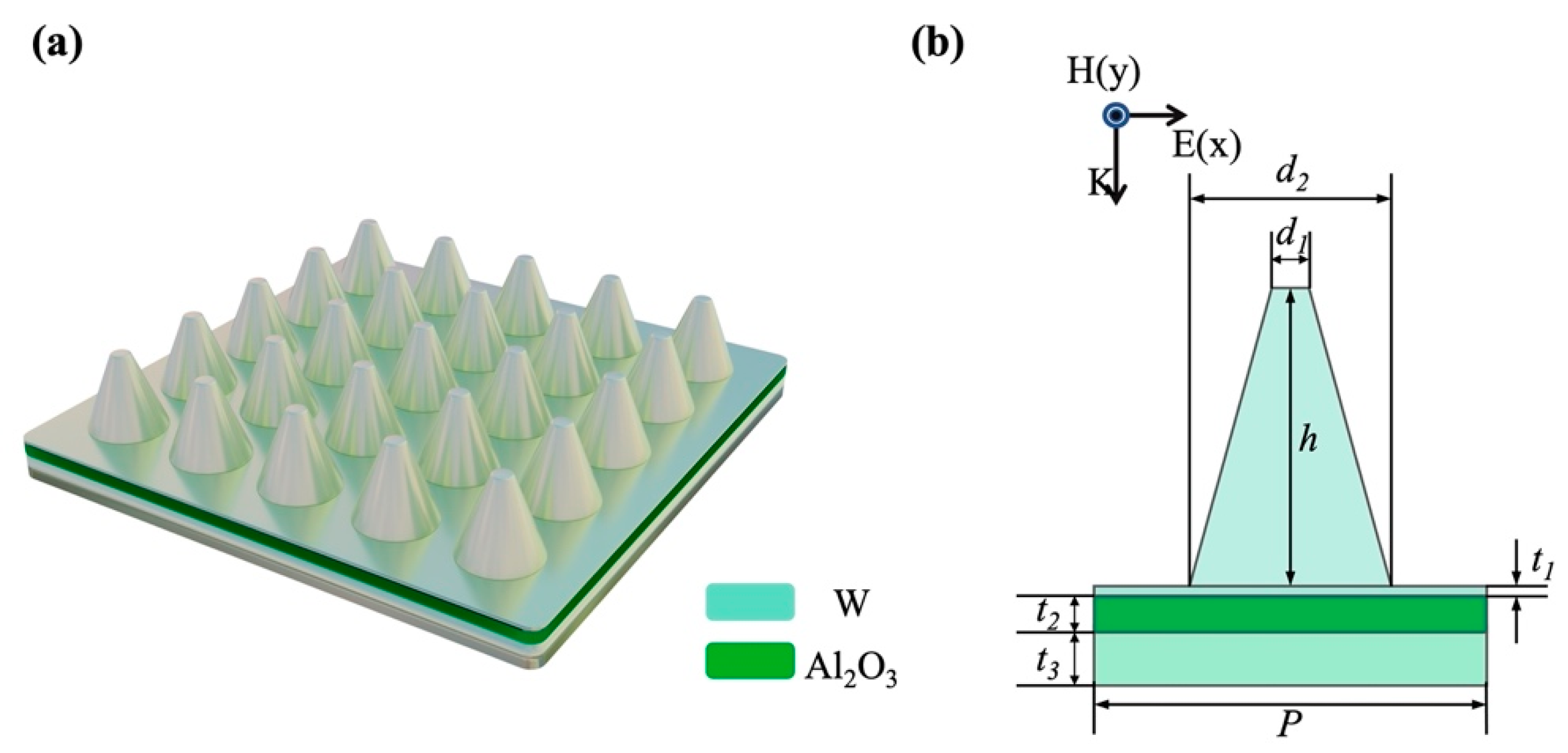
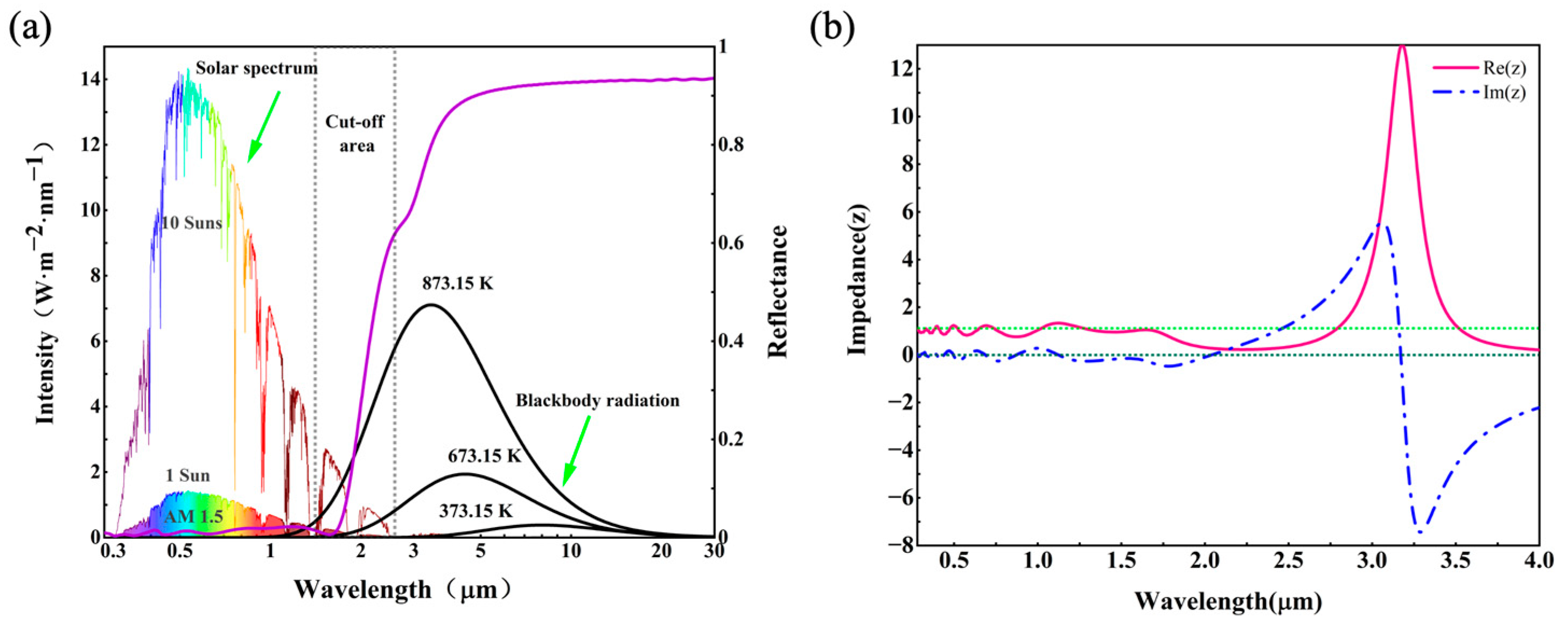

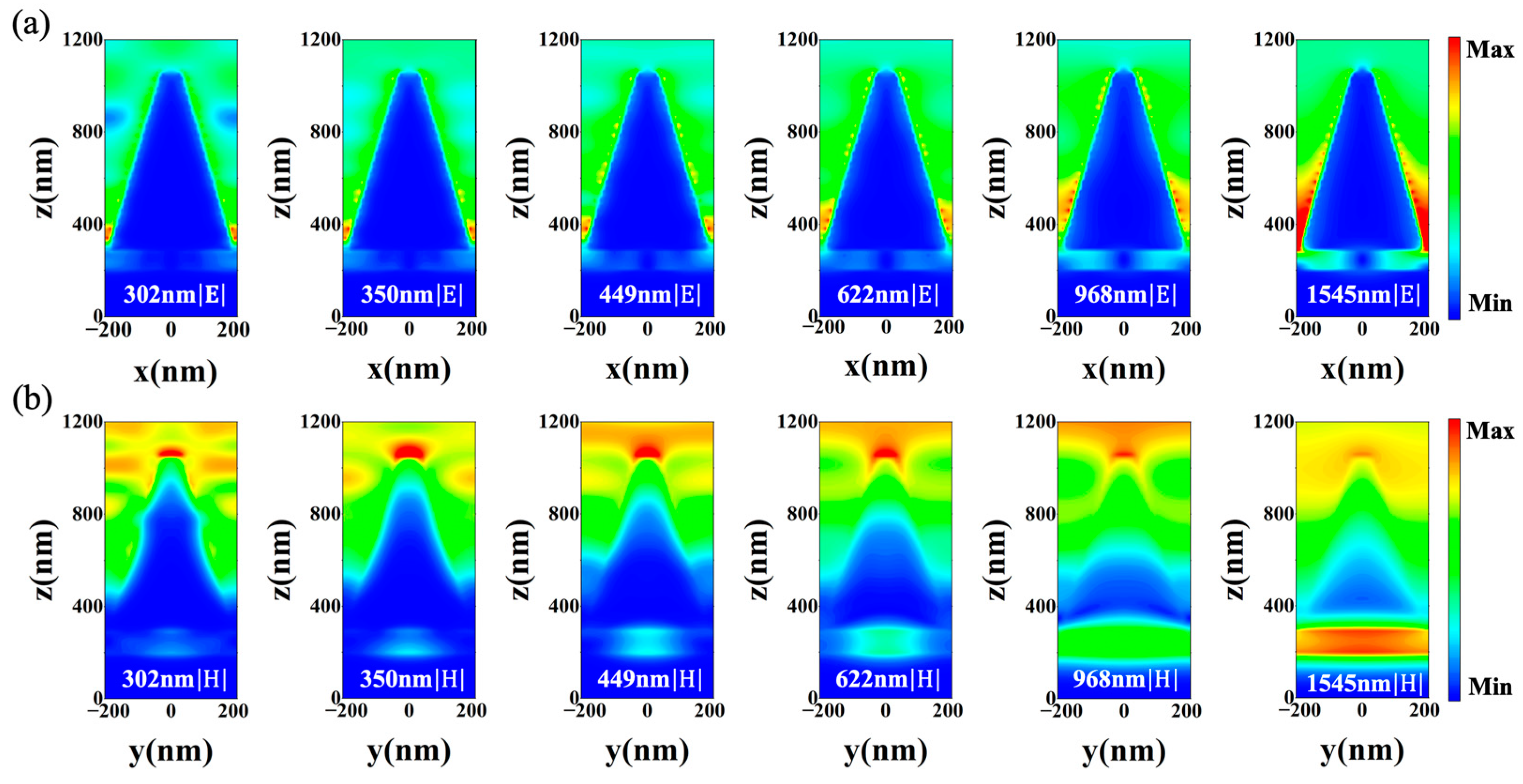

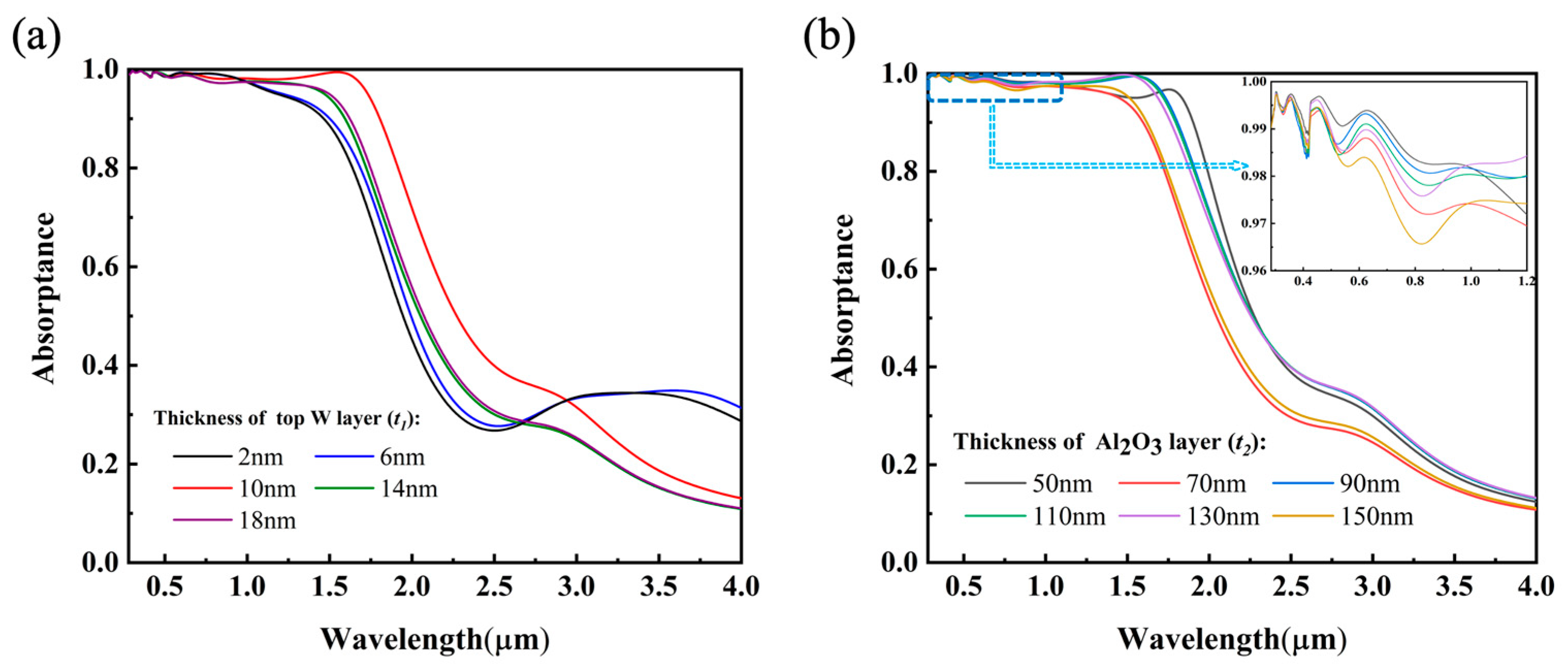
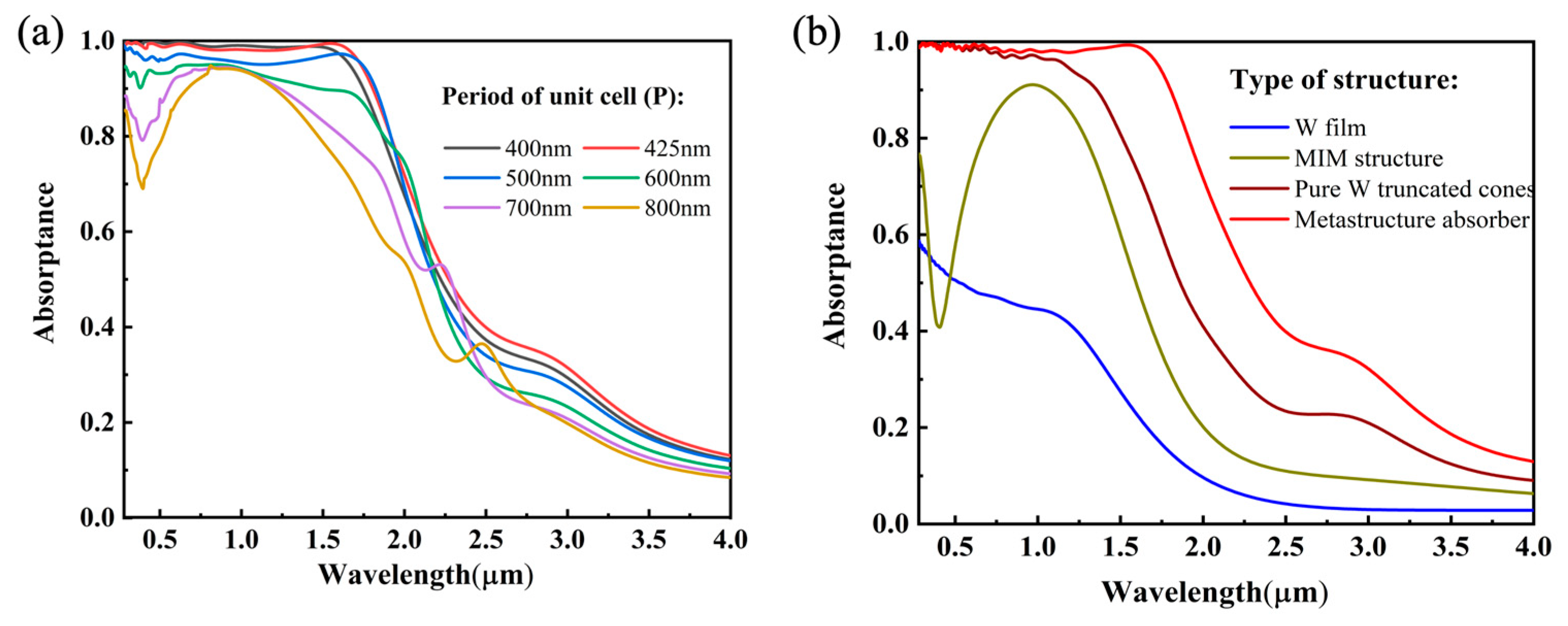



| Operating Temperature (K) | Solar Concentration Ratio C | |||
|---|---|---|---|---|
| 273.15 | 1 | 0.971 | 0.085 | 0.916 |
| 673.15 | 20 | 0.971 | 0.122 | 0.903 |
Publisher’s Note: MDPI stays neutral with regard to jurisdictional claims in published maps and institutional affiliations. |
© 2022 by the authors. Licensee MDPI, Basel, Switzerland. This article is an open access article distributed under the terms and conditions of the Creative Commons Attribution (CC BY) license (https://creativecommons.org/licenses/by/4.0/).
Share and Cite
Su, J.; Liu, D.; Sun, L.; Chen, G.; Ma, C.; Zhang, Q.; Li, X. Plasmonic Nanostructures for Broadband Solar Absorption Based on Synergistic Effect of Multiple Absorption Mechanisms. Nanomaterials 2022, 12, 4456. https://doi.org/10.3390/nano12244456
Su J, Liu D, Sun L, Chen G, Ma C, Zhang Q, Li X. Plasmonic Nanostructures for Broadband Solar Absorption Based on Synergistic Effect of Multiple Absorption Mechanisms. Nanomaterials. 2022; 12(24):4456. https://doi.org/10.3390/nano12244456
Chicago/Turabian StyleSu, Junli, Dingquan Liu, Leihao Sun, Gang Chen, Chong Ma, Qiuyu Zhang, and Xingyu Li. 2022. "Plasmonic Nanostructures for Broadband Solar Absorption Based on Synergistic Effect of Multiple Absorption Mechanisms" Nanomaterials 12, no. 24: 4456. https://doi.org/10.3390/nano12244456
APA StyleSu, J., Liu, D., Sun, L., Chen, G., Ma, C., Zhang, Q., & Li, X. (2022). Plasmonic Nanostructures for Broadband Solar Absorption Based on Synergistic Effect of Multiple Absorption Mechanisms. Nanomaterials, 12(24), 4456. https://doi.org/10.3390/nano12244456






